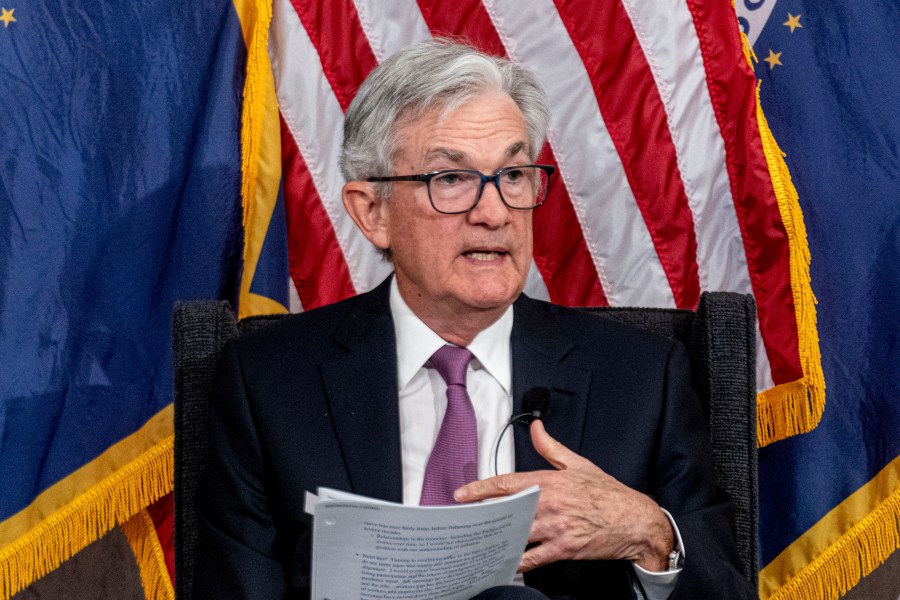Fed keeps interest rates unchanged for first time since January 2022
The Federal Reserve is taking a break from a rapid stretch of rate hikes as it approaches a critical crossroads in its battle with inflation.
The Fed’s rate-setting committee announced Wednesday it would keep its baseline interest rate range unchanged for the first time since January 2022.
The Fed funds rate range will remain at 5 to 5.25 percent, the highest level since 2008.
“Holding the target range steady at this meeting allows the Committee to assess additional information and its implications for monetary policy,” the Federal Open Market Committee (FOMC) said in a statement.
As inflation reached four-decade highs last summer, the Fed rapidly boosted rates to snuff out rapid price growth and cool off a historically strong job market. Higher interest rates tend to slow the economy and sap consumer demand, two of several forces behind inflation.

With inflation plunging toward the Fed’s target and the economy showing signs of slowing, the central bank is now taking a step back.
“We’ve moved much closer to our destination,” Federal Reserve Chairman Jerome Powell said during a Wednesday press conference, but said he and fellow officials are still on watch for a reversal.
“We’d like to see … credible evidence that inflation is topping out and then beginning to come down,” he continued.
The annual inflation rate is down 4 percent from 9.1 percent in June 2022, as measured by the Labor Department’s consumer price index.
Is the Fed’s approach working? Five takeaways from the steep May inflation decline
Economic growth has also cooled off, and several interest rate-sensitive industries, such as real estate and technology, have taken serious hits from higher borrowing costs.
“The inflation data supports the notion of at least a pause in the Federal Reserve’s rate hike campaign as it tries to push inflation back toward its long-term target of 2 percent,” wrote Joe Brusuelas, chief economist at audit and tax firm RSM, in a Tuesday analysis.
These early signs have given Fed officials comfort to hold off on another rate hike, especially since higher borrowing costs can take months — if not years — to make their full impact.
Even so, the job market has largely shaken off rate hikes meant to weaken it, and inflation is still roughly twice the Fed’s annual target. The resilience of the labor market and the stubbornness of inflation in some sectors have left the central bank on guard and unlikely to rest on its laurels.
“While we note that getting inflation from 9.1 perent to 4 percent will be easier than driving it down from 4 percent to 3 perent and then 3 percent to 2 percent, it is important to note that the direction and pipeline pressure inside the service sector are all moving in the right direction. And that is something to celebrate,” Brusuelas wrote.
On the horizon: Goldman Sachs sees lower chance of recession
While the Fed may be moving toward its long-sought victory against inflation, the next few months pose a gantlet for central bankers.
Fed officials will need to decide whether they have already done enough to keep the economy on track for lower inflation and risk prices bouncing back up, or add more pressure and potentially drive the U.S. into recession.
And the Fed doesn’t seem likely to pause for long.
Members of the FOMC expect to hike interest rates by another 0.5 percentage points before the end of the year, according to new economic projections released Wednesday. Fed officials only expected to hike one more time in March.
FOMC members also expect the economy to grow at a faster rate, the jobless rate to stay lower, and inflation to remain higher than they expected they would in March.
Fed officials expect gross domestic product (GDP) to grow 1 percent in 2023, much higher than the meager 0.4 percent gain they projected in March. They also expect the unemployment rate to settle at 4.1 percent by December, up from its May level of 3.7 percent but well short of the 4.6 percent jobless rate they projected in March.
FOMC members also expect annual inflation as measured by the personal consumption expenditures price index to settle at 3.2 percent in December — down from a 3.3 percent projection in March — but inflation without food and energy prices to hit 3.9 percent, up from the 3.6 percent annual rate projected in March.
Updated at 2:12 p.m.
Copyright 2023 Nexstar Media Inc. All rights reserved. This material may not be published, broadcast, rewritten, or redistributed.

